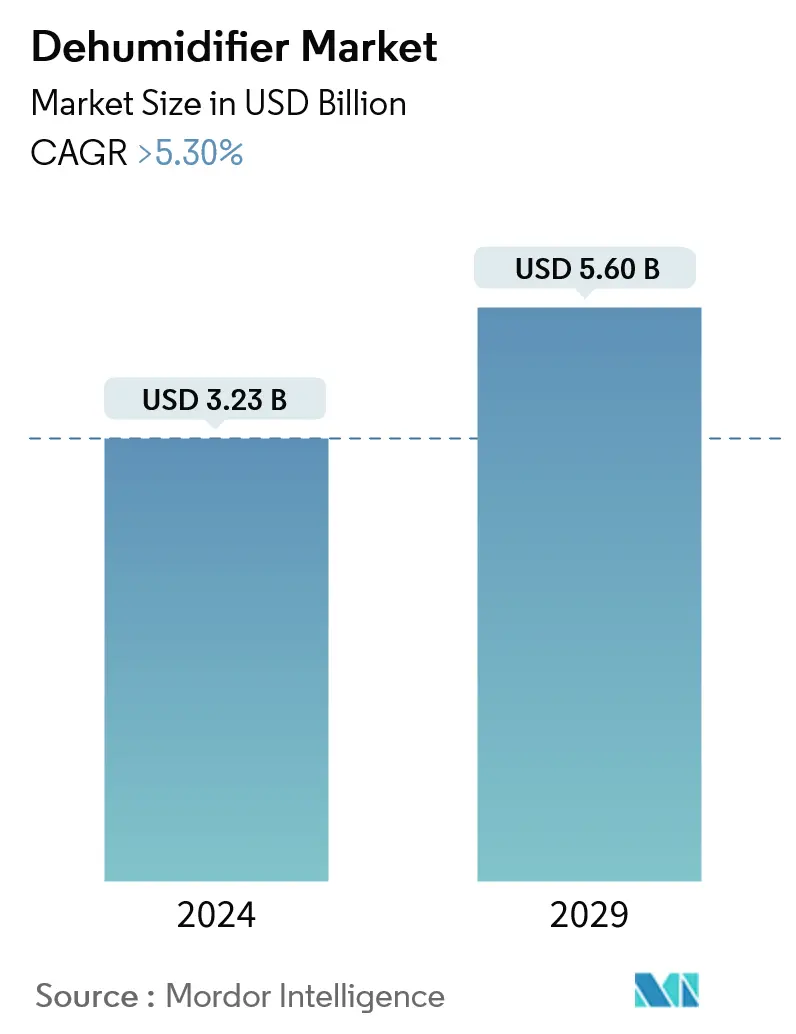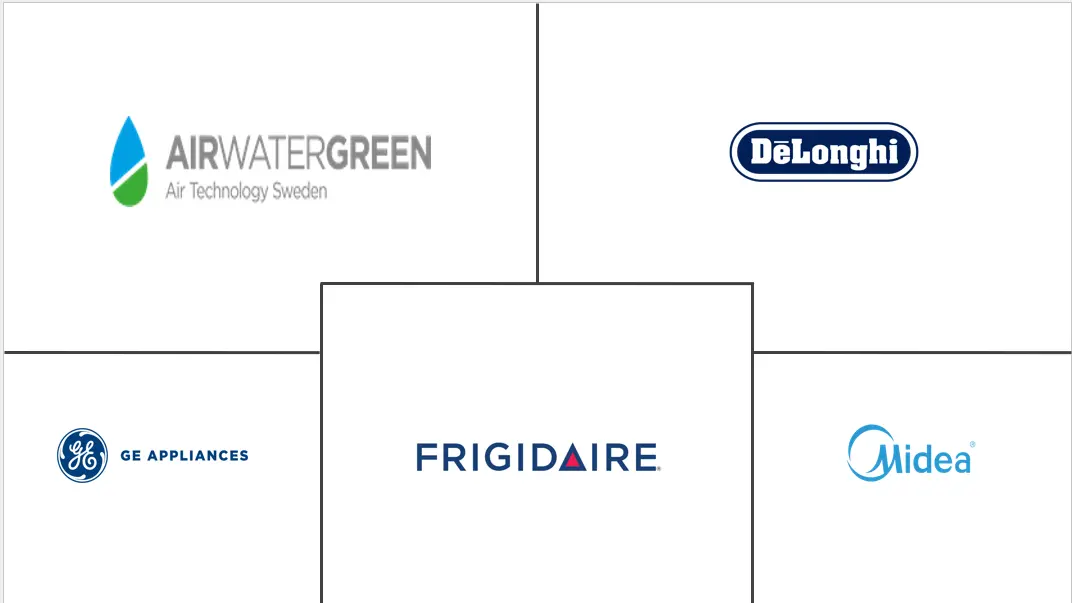Market Size of Dehumidifier Industry

| Study Period | 2020-2029 |
| Market Size (2024) | USD 3.23 Billion |
| Market Size (2029) | USD 5.60 Billion |
| CAGR (2024 - 2029) | 5.30 % |
| Fastest Growing Market | Asia Pacific |
| Largest Market | North America |
Major Players
*Disclaimer: Major Players sorted in no particular order |
Dehumidifier Market Analysis
The Dehumidifier Market size is estimated at USD 3.23 billion in 2024, and is expected to reach USD 5.60 billion by 2029, growing at a CAGR of greater than 5.30% during the forecast period (2024-2029).
Dehumidifiers are in high demand in the market because people are becoming more aware of the health risks of high humidity, especially in coastal regions during the summer months. People are becoming more aware that high humidity can lead to mold growth, allergies, and respiratory problems. People want to maintain good indoor air quality, and dehumidifiers are a great way to do that. Therefore, the market is likely to grow in the coming years.
Revenue growth in the market is mainly due to the growing use of household Dehumidifiers to regulate humidity levels and inhibit bacterial growth. North America is expected to have the biggest revenue share over the forecast period, mainly due to the region's growing spending on warehouse, residential, and commercial construction. U.S. spending on private construction skyrocketed since 2020. Demand for dehumidifiers is growing as construction activity increases, which in turn is driving market revenue growth.
The demand for this product is also due to the fact that extreme weather events are on the rise. Climate change means that more and more extreme weather is happening, like heavy rain and flooding. This can cause a lot of moisture and humidity in your home, so you want to make sure your home is as dry as possible. Dehumidifiers are a great way to keep humidity down, stop mold from growing, and protect your home. So, this is what's driving the demand for this product over the next few years.
Companies are delaying investments due to concerns about inflation and declining demand, which will result in lower capital expenditure in the near future. The developed markets appear ready for a recession due to their slower growth and higher inflation. Fears of further COVID-19 outbreaks combined with China's already precarious post-pandemic trajectory made it possible that the globe could face more severe manufacturing interruptions and supply chain problems that year. The intricacy of the problems encountered was exacerbated by unstable financial markets, escalating trade disputes, a more stringent regulatory framework, and a demand to include climate change in economic decisions.
Dehumidifier Industry Segmentation
Dehumidifiers are electrical appliances that are specifically designed to eliminate moisture from the atmosphere. The most commonly used dehumidifiers include desiccants, refrigerants, and other substances.
The global dehumidifier market is segmented by type (mechanical, chemical, and heat pumps), application (industrial, residential, and commercial), distribution channel (online and offline), and geography (North America, Europe, Asia-Pacific, and the Middle East and Africa).
The report offers market size and a forecast in value (USD) for all the above segments.
| By Product Type | |
| Mechanical | |
| Chemical | |
| Heat Pump |
| By Application | |
| Industrial | |
| Residential | |
| Commercial |
| By Distribution Channel | |
| Online | |
| Offline |
| By Geography | |
| North America | |
| Europe | |
| South America | |
| Asia-Pacific | |
| Middle East & Africa |
Dehumidifier Market Size Summary
The dehumidifier market is poised for significant growth over the forecast period, driven by increasing awareness of the health risks associated with high humidity levels, particularly in coastal regions during summer. As consumers become more conscious of the potential for mold growth, allergies, and respiratory issues, the demand for dehumidifiers to maintain optimal indoor air quality is rising. This trend is further fueled by the growing use of household dehumidifiers to regulate humidity and inhibit bacterial growth. North America is expected to dominate the market share, supported by increased spending on construction activities across residential, commercial, and warehouse sectors. The rise in extreme weather events, attributed to climate change, is also contributing to the demand for dehumidifiers, as they help mitigate moisture-related issues in homes.
The market is experiencing a shift towards smart technology integration, with manufacturers developing dehumidifiers equipped with advanced features like smart sensors, programmable timers, and compatibility with smart home systems. This innovation enhances energy efficiency and user convenience, driving demand in both residential and commercial spaces. The portable dehumidifier segment is particularly poised for growth, with new sustainable technologies such as solar-assisted and liquid desiccant dehumidifiers gaining traction. Despite challenges like inflation and potential economic downturns, the market remains competitive, with major players investing in new technologies and strategic partnerships to enhance their offerings. The global market is characterized by a mix of large and small players, all vying to capture market share through innovation and strategic expansions.
Dehumidifier Market Size - Table of Contents
-
1. MARKET DYNAMICS
-
1.1 Market Overview
-
1.2 Market Drivers
-
1.2.1 The need for residential dehumdifiers is growing as indoor air quality becomes widely recognized
-
1.2.2 Increasing frequency of extreme weather events fuels market expansion
-
-
1.3 Market Restraints
-
1.3.1 Growing respiratory issues brought on by pollutants produced in high-humidity settings
-
1.3.2 Limitations in terms of applications for desiccant dehumidifiers
-
-
1.4 Market Opportunities
-
1.4.1 Rise in demand for dry humdifier in the healthcare sector
-
1.4.2 Growing demand for residential and commercial activities
-
-
1.5 Porter's Five Forces Analysis
-
1.5.1 Bargaining Power of Suppliers
-
1.5.2 Bargaining Power of Buyers/Consumers
-
1.5.3 Threat of New Entrants
-
1.5.4 Threat of Substitute Products
-
1.5.5 Intensity of Competitive Rivalry
-
-
1.6 Impact of COVID-19 on the market
-
1.7 Insights on technological developments in the market
-
-
2. MARKET SEGMENTATION
-
2.1 By Product Type
-
2.1.1 Mechanical
-
2.1.2 Chemical
-
2.1.3 Heat Pump
-
-
2.2 By Application
-
2.2.1 Industrial
-
2.2.2 Residential
-
2.2.3 Commercial
-
-
2.3 By Distribution Channel
-
2.3.1 Online
-
2.3.2 Offline
-
-
2.4 By Geography
-
2.4.1 North America
-
2.4.2 Europe
-
2.4.3 South America
-
2.4.4 Asia-Pacific
-
2.4.5 Middle East & Africa
-
-
Dehumidifier Market Size FAQs
How big is the Dehumidifier Market?
The Dehumidifier Market size is expected to reach USD 3.23 billion in 2024 and grow at a CAGR of greater than 5.30% to reach USD 5.60 billion by 2029.
What is the current Dehumidifier Market size?
In 2024, the Dehumidifier Market size is expected to reach USD 3.23 billion.

